In Hindu mythology, Bhima is one of the Pandava brothers, the central characters in the epic Mahabharata. Bhima is known for his immense physical strength, courage, and loyalty. He is considered the second son of Kunti, the mother of the Pandavas, and the god Vayu, the wind deity.

The term “Bhima Avatar” is not commonly used in Hindu mythology to refer to an incarnation of a deity. However, if you are referring to a specific context or interpretation, it’s possible that the term is being used in a particular religious or cultural tradition.
If you have a more specific question or if there’s a particular aspect of Bhima or his stories that you’re interested in, feel free to provide more details, and I’ll do my best to assist you!
Bhima– ‘ओम ऐं मनो वंचिता सिद्धाय ऐम ऐं ओम’
‘Om Aim Mano Vanchita Siddhay Aim Aim Om’
Table of Content
Avatar Info
Bhima is one of the central characters in the Indian epic, Mahabharata. According to Hindu mythology, Bhima is the second of the Pandava brothers, the sons of King Pandu and Queen Kunti. He is known for his immense strength, courage, and loyalty. Bhima played a crucial role in the Kurukshetra War, a great battle between the Pandavas and the Kauravas.
The concept of Bhima Avatar, however, is associated with the Dashavatara, the ten incarnations of Lord Vishnu in Hinduism. In this context, Bhima is considered as the third avatar. The Dashavatara includes various forms in which Lord Vishnu incarnates to restore cosmic order (dharma) whenever it is threatened by evil forces.
The order of the Dashavatara is generally:
- Matsya (the fish)
- Kurma (the turtle)
- Varaha (the boar)
- Narasimha (the man-lion)
- Vamana (the dwarf)
- Parashurama (the warrior with an axe)
- Rama (the prince of Ayodhya)
- Krishna (the divine statesman and warrior)
- Buddha (the enlightened one)
- Kalki (the future warrior on a white horse)
In this list, Bhima is sometimes considered an avatar, highlighting his immense strength and role as a warrior. However, it’s important to note that interpretations and lists may vary in different traditions and texts.
If you are referring to a specific aspect or episode related to Bhima as an avatar, please provide more details for a more accurate response.
Incarnation
In Hinduism, Bhima is one of the Pandava brothers, the central figures in the Indian epic Mahabharata. Bhima is known for his immense strength, bravery, and loyalty. However, if you are referring to the term “Bhima Avatar” in the context of incarnations (avatars) of Lord Vishnu, there isn’t a specific “Bhima Avatar” commonly recognized in Hindu mythology.
Lord Vishnu is said to incarnate in various forms to restore cosmic order and protect dharma (righteousness). The most well-known avatars of Vishnu are the ten incarnations collectively known as the Dashavatara. These include Matsya (the fish), Kurma (the tortoise), Varaha (the boar), Narasimha (the man-lion), Vamana (the dwarf), Parashurama (the warrior with an axe), Rama (the prince of Ayodhya), Krishna (the divine statesman and warrior), Buddha (the enlightened one), and Kalki (the future warrior on a white horse, yet to come).
If you have a specific reference or context for “Bhima Avatar,” it might be related to a local or regional tradition, and I recommend consulting specific texts or sources that discuss that particular aspect of Hindu mythology.
Place of Avatar
Bhima Avatar is a concept from Hindu mythology, referring to an incarnation or manifestation of the god Vishnu as Bhima, one of the Pandava brothers from the epic Mahabharata. According to Hindu beliefs, Vishnu takes various avatars to restore cosmic order and protect dharma (righteousness).
The most well-known avatars of Vishnu are:
- Matsya (The Fish): The first avatar, who saved the ancient scriptures and the sage Manu from a great deluge.
- Kurma (The Tortoise): Vishnu took this form to support Mount Mandara during the churning of the ocean (Samudra Manthan).
- Varaha (The Boar): To rescue the Earth (personified as the goddess Bhudevi) from the demon Hiranyaksha, Vishnu took the form of a boar.
- Narasimha (The Man-Lion): Vishnu manifested as a half-man, half-lion to defeat the demon Hiranyakashipu, who couldn’t be killed by man or beast.
- Vamana (The Dwarf): Vishnu, in the form of a dwarf Brahmin, subdued the demon king Bali by taking three steps.
- Parashurama: Vishnu incarnated as Parashurama, a Brahmin warrior with an axe, to rid the world of corrupt Kshatriya rulers.
- Rama: The prince of Ayodhya, hero of the Ramayana, and a symbol of virtue and righteousness.
- Krishna: The central character of the Mahabharata, known for his teachings in the Bhagavad Gita and various miraculous feats.
- Buddha: Some interpretations consider Buddha as an avatar of Vishnu, emphasizing non-violence and compassion.
- Kalki (Yet to come): It is believed that Kalki will appear in the future as a warrior on a white horse to restore righteousness.
The Bhima Avatar, as a distinct avatar of Vishnu, is not explicitly mentioned in the classical Hindu scriptures. However, Bhima, one of the Pandava brothers, is a central character in the Mahabharata. If you have a specific context or interpretation of Bhima Avatar in mind, please provide more details so that I can offer a more tailored response.
Purpose
Pujas for Bhima Avatar
Puja Vidhi
Bhima, one of the Pandava brothers in the Hindu epic Mahabharata, is considered an avatar of Vayu, the wind god. Bhima is known for his immense strength and valor. If you want to perform pujas (rituals) dedicated to Bhima Avatar, you can follow general guidelines for worship and include specific aspects related to Bhima. Here is a simple outline you can follow:
Preparation:
- Cleanse Yourself: Before starting any puja, it’s essential to cleanse yourself by taking a bath and wearing clean clothes.
- Choose a Clean Space: Select a quiet and clean place for the puja.
Items Needed:
- Idol or Image of Bhima: Have an image or idol of Bhima for your worship. If an idol is not available, you can use a picture or mental image.
- Flowers: Offer fresh flowers, preferably red or yellow, which are considered auspicious.
- Incense: Light incense sticks to create a pleasant atmosphere.
- Lamp or Diya: Light a lamp with ghee or oil.
- Fruits: Offer fresh fruits as a symbol of purity.
- Sweets: Include sweets in your offerings, like laddoos or other favorites of Bhima.
- Water: Keep a bowl of water for purification.
Puja Procedure:
- Invocation (Avahan): Begin by invoking Lord Bhima. You can use a simple prayer like, “Om Vayuputraya Namaha,” meaning “Salutations to the Son of the Wind God.”
- Offer Flowers: Offer flowers at the feet of the idol or image of Bhima while chanting his name.
- Light the Lamp: Light the lamp and incense, symbolizing the dispelling of darkness and the purity of the worship.
- Recite Bhima Stotra: If available, recite or play any stotra (hymn) dedicated to Bhima.
- Mantra Chanting: Chant the following mantra associated with Bhima:
- “Om Vayuputraya Vidmahe Mahabalaya Dhimahi Tanno Bhima Prachodayat.”
- Offerings: Offer fruits and sweets to Bhima as a symbol of your devotion.
- Prayers and Personal Requests: Take a moment to express your gratitude, seek blessings, or make personal requests.
- Arati: Wave the lit lamp in front of the idol or image in a circular motion.
- Closing Prayer (Visarjan): Conclude the puja by thanking Bhima for his presence and blessings. You can say, “Om Shanti, Shanti, Shanti,” for peace.
- Distribution of Prasad: Conclude the puja by distributing the prasad (offered items) among family members or participants.
Remember, these are general guidelines, and you can personalize the puja based on your tradition and preferences. It’s essential to perform the puja with a sincere heart and devotion.
Puja Time
The concept of Puja time for specific avatars or deities can vary among different traditions and communities within Hinduism. Bhima is one of the Pandava brothers from the Hindu epic Mahabharata, known for his strength and valor.
If you are specifically looking for a puja time dedicated to Bhima Avatar, it’s essential to note that there might not be a universally recognized or prescribed time for such worship. However, you can perform puja or prayers to Bhima Avatar at any convenient time for you.
Typically, individuals or families may choose auspicious days like Ekadashi, Thursdays, or festivals associated with Lord Vishnu (as Bhima is considered an avatar of Lord Vishnu) for special prayers. Additionally, during important events or milestones in your life, you may choose to offer prayers to Bhima for strength and courage.
It’s always a good idea to consult with a knowledgeable priest or spiritual guide from your specific tradition for more personalized guidance on the timing and rituals for Bhima Avatar puja based on your cultural or familial practices.
Puja Benefits
Bhima, one of the Pandava brothers in the Hindu epic Mahabharata, is considered to be the second avatar of Lord Vishnu. The concept of avatars is central to Hinduism, where divine beings incarnate in various forms to restore cosmic order and protect dharma (righteousness). Bhima’s avatar is known as Bhimasena or Bhimashtami.
Performing puja (ritual worship) dedicated to Bhima avatar is believed to bring several benefits, as followers seek divine blessings and protection. Here are some potential benefits associated with Bhima avatar puja:
- Strength and Courage: Bhima is renowned for his immense physical strength and courage. Worshipers may seek these qualities to face challenges and obstacles in their lives with determination and fearlessness.
- Protection: Devotees believe that Bhima’s blessings can provide protection from various dangers and threats. They may pray for safeguarding themselves and their loved ones from harm.
- Health and Well-being: The strength and vitality associated with Bhima can be invoked for promoting good health and overall well-being. Devotees may seek relief from ailments and the energy to lead a robust life.
- Victory in Battles: Bhima played a crucial role in the Kurukshetra War, and his valor contributed to the victory of the Pandavas. Worshipers may perform puja to seek success in their personal battles and endeavors.
- Devotion and Bhakti: Through the puja, individuals express their devotion and reverence to Bhima as a divine being. This can strengthen their spiritual connection and foster a sense of inner peace.
- Family Harmony: The Pandavas, including Bhima, are often seen as symbols of familial unity. Puja for Bhima may be performed to seek harmony, love, and understanding within the family.
- Dharma and Righteousness: Bhima, as a righteous warrior, is associated with upholding dharma. Devotees may seek inspiration and guidance in leading a righteous life through the worship of Bhima.
It’s important to note that the specific rituals and customs associated with Bhima avatar puja may vary among different traditions and regions. Individuals observing this puja often recite prayers, offer fruits, flowers, and other symbolic offerings, and may also engage in devotional activities.
As with any religious practice, the true benefits are believed to come from sincere devotion, faith, and the purity of one’s intentions.

